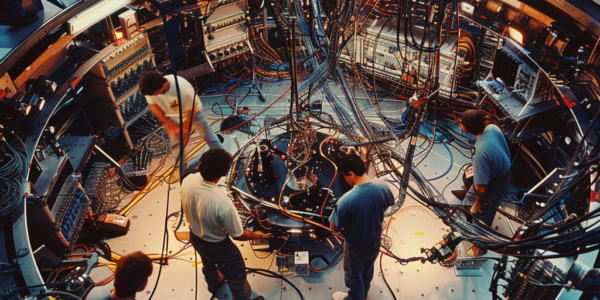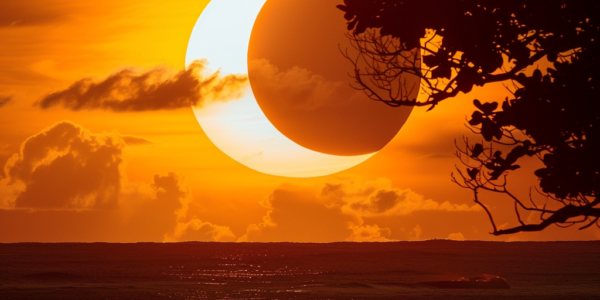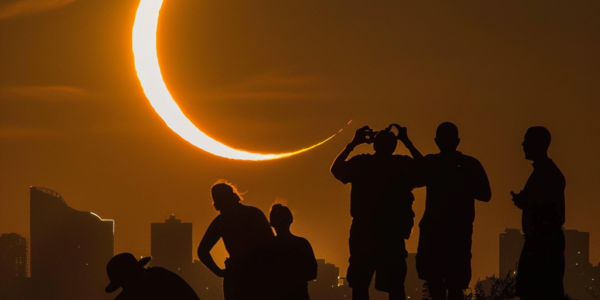NASA and Verizon Business Partner to Bring Live Broadcast of Solar Eclipse
NASA has partnered with Verizon Business to bring a live broadcast of the upcoming solar eclipse to viewers worldwide. The collaboration involves a 1 gigabyte E-line service connecting the John Glenn Space Center to the Great Lakes Science Center, enabling the transmission of feeds to a global audience. This groundbreaking partnership highlights Verizon’s ability to deliver solutions for federal agencies like NASA.
Texas City Baking World’s Largest Moon Pie for Solar Eclipse Viewing Event
Irving, Texas is baking the ‘world’s largest moon pie’ to celebrate the upcoming solar eclipse. The public can try a slice at Total Eclipse in the Park, a viewing event featuring live music, eclipse glasses, and space-themed food. The event will be held on Monday, April 8 at Heritage Park and Levy Event Plaza.
Millions Await Total Solar Eclipse Across North America
Millions of spectators eagerly awaited Monday’s total eclipse of the sun, with a partial eclipse first spotted in Hawaii. Experts say the eclipse began at 6:33 a.m. and peaked at 7:12 a.m., expected to last until 7:54 a.m. Share your photos and videos of the natural phenomenon!
Highly Anticipated Total Solar Eclipse Set to Captivate Millions
The highly anticipated total solar eclipse, known as the Great American Eclipse, is set to captivate millions as it crosses the continental United States from southern Texas to northern Maine. With an estimated 34 million Americans expected to witness the eclipse, it’s important to understand the event and its path of totality, which includes states such as Texas, Ohio, and New York. Scheduled for April 8, 2024, from 2:27 p.m. to 3:35 p.m. Eastern time, this celestial event will bring a temporary darkening of the sky and a decrease in temperature.
Understanding the Dangers of Viewing the 2024 Solar Eclipse
Millions of Americans are eagerly anticipating the upcoming solar eclipse on April 8, 2024. However, it’s crucial to understand the potential dangers associated with viewing this natural phenomenon. NASA emphasizes the importance of eye protection during both partial and total solar eclipses. Looking directly at the sun, even during a partial eclipse, can lead to eye damage. Dr. Yehia Hashad, an ophthalmologist and retinal specialist at Bausch + Lomb, warns that there is no safe level of exposure to solar ultraviolet rays or infrared radiation. Given the dangers associated with viewing a solar eclipse, it’s crucial to use special glasses specifically designed for eclipse viewing.
Health’s Weekend Read: Solar Eclipse Eye Safety, Bird Flu Warnings, and More
Stay informed with the latest health news from Fox News Digital, covering topics such as solar eclipse eye safety, bird flu warnings, cancer prevention, and personal stories of triumph over adversity. Learn about the potential eye damage from staring at the sun, the risk of a future bird flu pandemic, the significance of Cancer Prevention and Early Detection Month, and how one husband is using AI to combat colon cancer after the loss of his wife.
Bowie State University to Host Solar Eclipse Watch Party
Join Bowie State University for a Solar Eclipse Watch Party on April 8, 2024, featuring a presentation by NASA engineers and 3000 pairs of eclipse glasses for attendees. Learn about the rare celestial event and the importance of safety while viewing the eclipse. Open to the public and free to attend, this event promises to be an educational and awe-inspiring experience.
Millions Prepare to Witness Total Solar Eclipse Across North America
The much-anticipated total solar eclipse is finally here, creating a celestial spectacle in the skies over the United States, Mexico, and Canada. After a nearly seven-year wait, millions of people are gearing up to witness this extraordinary event. The eclipse will first make its appearance over the South Pacific Ocean before journeying across North America. CNN will be providing live coverage of the solar eclipse for those unable to witness it in person. It’s important to ensure safety when viewing the eclipse by using certified eclipse glasses or a solar viewer.
The 2017 Total Solar Eclipse: A Memorable Celestial Event for Millions of Americans
The last total solar eclipse in the United States occurred on Monday, Aug. 21, 2017, captivating eclipse-chasers across the country. The path of totality spanned from Salem, Oregon, to Charleston, South Carolina, making it the first eclipse in 99 years visible across the entire country. The lunar shadow, cast by the moon on the Earth’s surface as it was back-lit by the sun, entered the U.S. near Lincoln City, Oregon, at 9:05 a.m. local time, reaching totality there at 10:16 a.m. local time. The darkness of totality hit watchers in Charleston, South Carolina, at 2:48 p.m. local time, and the last of the lunar shadow left the U.S. at 4:09 p.m. ET. A partial eclipse was visible throughout the United States, providing a memorable celestial event for millions of Americans.
Total Solar Eclipse to Cross North America on April 8, 2024
The total solar eclipse on April 8, 2024, will traverse 15 U.S. states, with an estimated 31.6 million people residing in the path of totality. The eclipse’s trajectory is projected to span between 108 and 122 miles in width, with an additional 150 million individuals situated within 200 miles of the path of totality. Major cities across the U.S. fall within the eclipse’s path of totality, and a map provided by NASA offers insights into the timing of when the solar eclipse will reach totality across the path.










